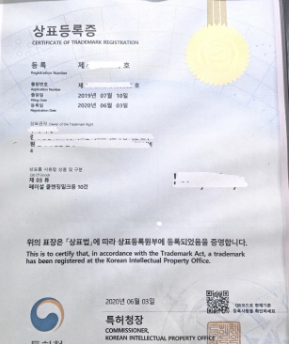The First Step to Tapping into the Korean Market: Secure Your Korean Trademark and Obtain the Coupang Brand Blue Label Pass!
In the fiercely competitive Korean market (especially on the Coupang platform), an increasing number of sellers have noticed a phenomenon: the product titles of those that rank highly and enjoy brisk sales often feature a prominent blue brand logo at the top. This small blue logo not only enhances the professional image of the product but also serves as an important symbol of consumer trust.
For cross-border sellers aiming to establish a long-term presence in the South Korean e-commerce market, obtaining brand blue badge certification has become an essential step in enhancing competitiveness. The starting point for this process is a trademark certificate registered in South Korea.
The Role of the Coupang Brand Blue Badge
On Coupang, the brand blue badge has become a symbol of quality and credibility. Products with the blue badge not only enjoy higher visibility but also effectively avoid the hassle of being counterfeited by other sellers.
“When your product starts selling well, only to suddenly discover it's being counterfeited by other sellers, stealing your traffic and sales,” a seasoned seller confessed, “this pain can only be understood by those who've experienced it. Brand certification is the ultimate solution to this problem.”
The core requirement for obtaining the Brand Blue Label is simple: you must hold a Korean domestic trademark registration certificate. Trademarks registered in other countries are not recognized, nor are trademarks currently under application (™). Only fully registered trademarks (R) qualify.
The Multiple Values of Korean Trademark Registration
1. A Powerful Tool Against Counterfeiting
Establish competitive barriers to prevent counterfeiters from eroding market share for popular products, allowing sellers to focus on product development and optimization.
2. Foundation for Brand Premium
Korean consumers have strong brand awareness. Registered trademarks help build brand recognition and enhance product premium potential, with the highest premium reaching up to 30%.
3. Asset Appreciation Tool
As an intangible asset, trademarks appreciate in value as the business grows and can be used for collateral loans, equity financing, etc., providing financial support for business expansion.
4. Comprehensive Platform Protection
When selling on Korean e-commerce platforms such as Gmarket and 11st, trademark registration proof is also required. Failure to register may result in product removal or account suspension.
Analysis of the South Korean Trademark Registration Process
1. Preparation of Materials
① Trademark Design: Can be in black and white or color, but must clearly display the details of the trademark.
② List of Goods or Services: Classify your goods or services according to South Korea's classification system.
③ Registrant Information: Includes business license, ID card, contact information, etc.
④ Power of Attorney: Provided by our agency (trademark agency).
2. Submit the Application
Submit the required application documents to the Korean Intellectual Property Office (KIPO) to process the trademark registration application.
3. Formal Review
KIPO verifies the completeness of the documents. If any deficiencies are found, corrections must be made within 30 days; otherwise, the application will be deemed withdrawn.
4. Substantive Examination
Examiners assess the distinctiveness of the trademark, whether it violates prohibited provisions, and whether it conflicts with prior rights.
5. Publication and Opposition
After passing the examination, the trademark will be published on the KIPO official website for a period of 3 months. Third parties may file objections, and we provide real-time monitoring and opposition response solutions.
6. Approval and Issuance of Certificate
If no objections are raised or objections are deemed invalid, the trademark registration certificate will be issued after payment of the registration fee. The certificate is valid for 10 years and may be renewed indefinitely.
(Renewal can be processed within six months prior to the trademark's expiration date, with a grace period of six months, and the renewal term is 10 years.)
Note: Avoid cultural conflicts: When designing and selecting a trademark, please consider South Korea's cultural background and customs to avoid using symbols that may cause cultural conflicts or negative associations.

 South Korean Patent Registrati
South Korean Patent Registrati
 The First Step to Tapping into
The First Step to Tapping into
 Spanish VAT compliance upgrade
Spanish VAT compliance upgrade
 EU Battery Law Coming into Eff
EU Battery Law Coming into Eff
